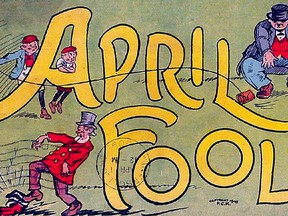Did you hear? Justin Trudeau has resigned and is asking Vladimir Putin to annex Canada and support his war with Ukraine!

Did you hear? Justin Trudeau has resigned and is asking Vladimir Putin to annex Canada and support his war with Ukraine!
Advertisement 2
Article content
OK, this isn’t true. It’s just a bit of early April Fool’s Day foolery ahead of Monday, April 1.
Article content
How did this weird day begin? Nobody knows for sure. But it is a very old celebration. One version of its origin, which does seem to make sense, dates from 1582, when France switched from the Julian to the Gregorian calendar. People who were slow to recognize that the start of the new year had moved to Jan. 1 and continued to celebrate it in the last week of March through April 1 became the butt of jokes and hoaxes. Often, these people were sent on impossible tasks that became known as “fools’ errands.”
In early April Fool’s Day, French children would pin a paper fish to their friends’ backs and when the victim found out, yell “poisson d’Avril” (April fish) symbolizing a young, easily caught fish or a gullible person. These pranks spread eventually to England.
Advertisement 3
Article content
As early as 1698, several people heard seemingly reliable reports that “lions would be washed at the Tower of London” on April 1. Even more were fooled when the prank was resurrected in 1856 and newspapers reported the “lions of the Tower of London” would be washed at the tower’s White Gate April 1. (After visiting in 2022, I learned the Tower had a collection of exotic animals for some time, but never made a public display of washing them.)
Another famous April Fool’s Days prank heralded the Swiss spaghetti harvest in Ticino, Italy, on April 1, 1957. People were led to believe spaghetti in Italy grew on trees and, to experience the phenomenon, you had to “place a strand of spaghetti in a tin of tomato sauce and wait for it to grow.”
Advertisement 4
Article content
In more recent times Taco Bell took out a full-page ad saying they had purchased the original Liberty Bell from the City of Philadelphia, which was to be renamed “The Taco Liberty Bell” on April 1. This ad was followed by a report that the Lincoln Memorial in Washington had been purchased by the Ford Motor Co. and would be rechristened “The Ford Lincoln Mercury Memorial.” Needless to say, that caused an uproar!
On March 31, 1989, a large craft looking like a UFO passed over London, England, and landed at a stadium outside the city. When police approached the strange craft, a small, silver-clad figure emerged. It turned out that controversial and larger-than-life entrepreneur Richard Branson had orchestrated the entire April Fool’s Day hoax using a balloon for the UFO.
Advertisement 5
Article content
A number of my friends in 1985 were excited about an April Sports Illustrated article spotlighting a New York Mets rookie, named Sidd Finch, who supposedly could throw a 168 mph (270 km/h) fastball — 65 mph (104 km/h) faster than any previous pitch. I had, by coincidence, read about this April Fool’s Day hoax and gently explained this to the first few people who brought it up; after seeing their disappointment, I decided to keep my mouth shut and be “amazed.” After all, how could a magazine like Sports Illustrated and a noted writer like George Plimpton ever fool around with something as serious and sacred as baseball!?
I am sure that all of us have had an April Fool’s Day joke pulled on us, and I’m sure for the most part I am sure we laughed at our gullible nature and our ability to be fooled by the unbelievable, inconceivable, or just plain stupid.
I’m just glad that I am no longer teaching, and don’t have to anticipate a series of student jokes on April Fool’s Day. All I have to deal with is my grandson, Harrison, who delights in fooling his gullible old grandfather!
Article content